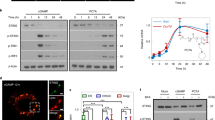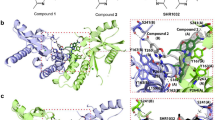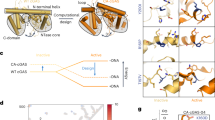Abstract
Agonists of mouse STING (TMEM173) shrink and even cure solid tumors by activating innate immunity; human STING (hSTING) agonists are needed to test this therapeutic hypothesis in humans. The endogenous STING agonist is 2′3′-cGAMP, a second messenger that signals the presence of cytosolic double-stranded DNA. We report activity-guided partial purification and identification of ecto-nucleotide pyrophosphatase/phosphodiesterase (ENPP1) to be the dominant 2′3′-cGAMP hydrolyzing activity in cultured cells. The hydrolysis activity of ENPP1 was confirmed using recombinant protein and was depleted in tissue extracts and plasma from Enpp1−/− mice. We synthesized a hydrolysis-resistant bisphosphothioate analog of 2′3′-cGAMP (2′3′-cGsAsMP) that has similar affinity for hSTING in vitro and is ten times more potent at inducing IFN-β secretion from human THP1 monocytes. Studies in mouse Enpp1−/− lung fibroblasts indicate that resistance to hydrolysis contributes substantially to its higher potency. 2′3′-cGsAsMP is therefore improved over natural 2′3′-cGAMP as a model agonist and has potential as a vaccine adjuvant and cancer therapeutic.
This is a preview of subscription content, access via your institution
Access options
Subscribe to this journal
Receive 12 print issues and online access
$259.00 per year
only $21.58 per issue
Buy this article
- Purchase on Springer Link
- Instant access to full article PDF
Prices may be subject to local taxes which are calculated during checkout





Similar content being viewed by others
Change history
29 January 2015
In the version of this article initially published, the chemical structures of the two cyclic dinucleotides in Figure 4a were incorrect at the triphosphate group, with each of the phosphates shown as containing two extra hydrogen atoms. The error has been corrected in the HTML and PDF versions of the article.
15 July 2015
In the version of this article published on 29 January 2015, in Figure 4 the hydroxyl group was depicted in the 3′ position on the deoxyribose ring of the cyclic dinucleotide precursor to 3′3′-cGAMP rather than in the 2′ position and the R group was in the 2′ position rather than in the 3′ position. This error has been corrected in the HTML and PDF versions of the article.
References
Duthie, M.S., Windish, H.P., Fox, C.B. & Reed, S.G. Use of defined TLR ligands as adjuvants within human vaccines. Immunol. Rev. 239, 178–196 (2011).
Coffman, R.L., Sher, A. & Seder, R.A. Vaccine adjuvants: putting innate immunity to work. Immunity 33, 492–503 (2010).
Hemmi, H. et al. Small anti-viral compounds activate immune cells via the TLR7 MyD88-dependent signaling pathway. Nat. Immunol. 3, 196–200 (2002).
Ishikawa, H. & Barber, G.N. STING is an endoplasmic reticulum adaptor that facilitates innate immune signalling. Nature 455, 674–678 (2008).
Zhong, B. et al. The adaptor protein MITA links virus-sensing receptors to IRF3 transcription factor activation. Immunity 29, 538–550 (2008).
Wu, J. et al. Cyclic GMP-AMP is an endogenous second messenger in innate immune signaling by cytosolic DNA. Science 339, 826–830 (2013).
Kim, S. et al. Anticancer flavonoids are mouse-selective STING agonists. ACS Chem. Biol. 8, 1396–1401 (2013).
Conlon, J. et al. Mouse, but not human STING, binds and signals in response to the vascular disrupting agent 5,6-dimethylxanthenone-4-acetic acid. J. Immunol. 190, 5216–5225 (2013).
Gao, P. et al. Structure-function analysis of STING activation by c[G(2′,5′)pA(3′,5′)p] and targeting by antiviral DMXAA. Cell 154, 748–762 (2013).
Burdette, D.L. et al. STING is a direct innate immune sensor of cyclic di-GMP. Nature 478, 515–518 (2011).
Tanaka, Y. & Chen, Z.J. STING specifies IRF3 phosphorylation by TBK1 in the cytosolic DNA signaling pathway. Sci. Signal. 5, ra20 (2012).
Davies, B.W., Bogard, R.W., Young, T.S. & Mekalanos, J.J. Coordinated regulation of accessory genetic elements produces cyclic di-nucleotides for V. cholerae virulence. Cell 149, 358–370 (2012).
Zhang, X. et al. Cyclic GMP-AMP containing mixed phosphodiester linkages is an endogenous high-affinity ligand for STING. Mol. Cell 51, 226–235 (2013).
Ablasser, A. et al. cGAS produces a 2′-5′-linked cyclic dinucleotide second messenger that activates STING. Nature 498, 380–384 (2013).
Diner, E.J. et al. The innate immune DNA sensor cGAS produces a noncanonical cyclic dinucleotide that activates human STING. Cell Rep. 3, 1355–1361 (2013).
Li, X.D. et al. Pivotal roles of cGAS-cGAMP signaling in antiviral defense and immune adjuvant effects. Science 341, 1390–1394 (2013).
Bender, A.T. & Beavo, J.A. Cyclic nucleotide phosphodiesterases: molecular regulation to clinical use. Pharmacol. Rev. 58, 488–520 (2006).
Maurice, D.H. et al. Advances in targeting cyclic nucleotide phosphodiesterases. Nat. Rev. Drug Discov. 13, 290–314 (2014).
Wielinga, P.R. et al. Characterization of the MRP4- and MRP5-mediated transport of cyclic nucleotides from intact cells. J. Biol. Chem. 278, 17664–17671 (2003).
Jedlitschky, G., Burchell, B. & Keppler, D. The multidrug resistance protein 5 functions as an ATP-dependent export pump for cyclic nucleotides. J. Biol. Chem. 275, 30069–30074 (2000).
Guo, Y. et al. MRP8, ATP-binding cassette C11 (ABCC11), is a cyclic nucleotide efflux pump and a resistance factor for fluoropyrimidines 2′,3′-dideoxycytidine and 9′-(2′-phosphonylmethoxyethyl)adenine. J. Biol. Chem. 278, 29509–29514 (2003).
Gao, P. et al. Cyclic [G(2′,5′)pA(3′,5′)p] is the metazoan second messenger produced by DNA-activated cyclic GMP-AMP synthase. Cell 153, 1094–1107 (2013).
Sun, L., Wu, J., Du, F., Chen, X. & Chen, Z.J. Cyclic GMP-AMP synthase is a cytosolic DNA sensor that activates the type I interferon pathway. Science 339, 786–791 (2013).
Kubota, K. et al. Identification of 2′-phosphodiesterase, which plays a role in the 2–5A system regulated by interferon. J. Biol. Chem. 279, 37832–37841 (2004).
Poulsen, J.B. et al. Human 2′-phosphodiesterase localizes to the mitochondrial matrix with a putative function in mitochondrial RNA turnover. Nucleic Acids Res. 39, 3754–3770 (2011).
Goding, J.W. et al. Ecto-phosphodiesterase/pyrophosphatase of lymphocytes and non-lymphoid cells: structure and function of the PC-1 family. Immunol. Rev. 161, 11–26 (1998).
Bollen, M., Gijsbers, R., Ceulemans, H., Stalmans, W. & Stefan, C. Nucleotide pyrophosphatases/phosphodiesterases on the move. Crit. Rev. Biochem. Mol. Biol. 35, 393–432 (2000).
Bischoff, E., Tran-Thi, T.A. & Decker, K.F. Nucleotide pyrophosphatase of rat liver. A comparative study on the enzymes solubilized and purified from plasma membrane and endoplasmic reticulum. Eur. J. Biochem. 51, 353–361 (1975).
Kato, K. et al. Crystal structure of Enpp1, an extracellular glycoprotein involved in bone mineralization and insulin signaling. Proc. Natl. Acad. Sci. USA 109, 16876–16881 (2012).
Belli, S.I., van Driel, I.R. & Goding, J.W. Identification and characterization of a soluble form of the plasma cell membrane glycoprotein PC-1 (5′-nucleotide phosphodiesterase). Eur. J. Biochem. 217, 421–428 (1993).
Rutsch, F. et al. PC-1 nucleoside triphosphate pyrophosphohydrolase deficiency in idiopathic infantile arterial calcification. Am. J. Pathol. 158, 543–554 (2001).
Hessle, L. et al. Tissue-nonspecific alkaline phosphatase and plasma cell membrane glycoprotein-1 are central antagonistic regulators of bone mineralization. Proc. Natl. Acad. Sci. USA 99, 9445–9449 (2002).
Lau, W.M. et al. Enpp1: A potential facilitator of breast cancer bone metastasis. PLoS ONE 8, e66752 (2013).
Umar, A. et al. Identification of a putative protein profile associated with tamoxifen therapy resistance in breast cancer. Mol. Cell. Proteomics 8, 1278–1294 (2009).
Meyre, D. et al. Variants of ENPP1 are associated with childhood and adult obesity and increase the risk of glucose intolerance and type 2 diabetes. Nat. Genet. 37, 863–867 (2005).
Rey, D. et al. Amerindians show no association of PC-1 gene Gln121 allele and obesity: a thrifty gene population genetics. Mol. Biol. Rep. 39, 7687–7693 (2012).
Maddux, B.A. et al. Membrane glycoprotein PC-1 and insulin resistance in non-insulin-dependent diabetes mellitus. Nature 373, 448–451 (1995).
Chin, C.N. et al. Evidence that inhibition of insulin receptor signaling activity by PC-1/ENPP1 is dependent on its enzyme activity. Eur. J. Pharmacol. 606, 17–24 (2009).
Konno, H., Konno, K. & Barber, G.N. Cyclic dinucleotides trigger ULK1 (ATG1) phosphorylation of STING to prevent sustained innate immune signaling. Cell 155, 688–698 (2013).
Liang, Q. et al. Crosstalk between the cGAS DNA sensor and Beclin-1 autophagy protein shapes innate antimicrobial immune responses. Cell Host Microbe 15, 228–238 (2014).
Ablasser, A. et al. Cell intrinsic immunity spreads to bystander cells via the intercellular transfer of cGAMP. Nature 503, 530–534 (2013).
Sali,, A.F.J.M., Terkeltaub, R. & Goding, J.W. in Ecto-ATPases and Related Ectonucleotidases (eds. Vanduffel, L. & Lemmens, R.) 267–282 (Shaker Publishing BV, Maastricht, the Netherlands, 1999).
Narisawa, S. et al. Novel inhibitors of alkaline phosphatase suppress vascular smooth muscle cell calcification. J. Bone Miner. Res. 22, 1700–1710 (2007).
Acknowledgements
We thank P. Koch, P. Choi, K. Krukenberg, A. Groen, M. Loose, S. Kim and S. Gruver for helpful discussions. We thank R. Jiang for help with data analysis. We thank K. Chu for providing mouse livers. We thank S. Walker for sharing the MicroBeta plate reader and C. Fan for technical assistance. We thank J.J. Mekalanos for providing the DncV expression plasmid and T. Bernhard (both from Harvard Medical School) for providing the pTB146 plasmid. We thank G. Heffron and C. Sheahan for assistance with the NMR data collection and analysis. We thank R. Ward for help with manuscript preparation. This research was supported by the National Cancer Institute (CA139980, AR53102, AI050872 and 1K99AI108793-01). L. Li thanks the Jane Coffin Childs Fund for her postdoctoral fellowship.
Author information
Authors and Affiliations
Contributions
L.L. and T.J.M. developed the hypothesis and designed the study. L.L., Q.Y., P.K. and Z.M. conducted the experiments. All authors interpreted and discussed the results. J.L.M. advised P.K., and H.W. advised Q.Y. Both J.L.M. and H.W. funded part of the research. L.L. and T.J.M. wrote the manuscript.
Corresponding author
Ethics declarations
Competing interests
The authors declare no competing financial interests.
Supplementary information
Supplementary Text and Figures
Supplementary Results and Supplementary Figures 1–15. (PDF 29368 kb)
Supplementary Data Set 1
Mass spectrometry analysis of fraction 26. (XLSX 77 kb)
Rights and permissions
About this article
Cite this article
Li, L., Yin, Q., Kuss, P. et al. Hydrolysis of 2′3′-cGAMP by ENPP1 and design of nonhydrolyzable analogs. Nat Chem Biol 10, 1043–1048 (2014). https://doi.org/10.1038/nchembio.1661
Received:
Accepted:
Published:
Issue Date:
DOI: https://doi.org/10.1038/nchembio.1661
This article is cited by
-
Second messenger 2'3'-cyclic GMP-AMP (2'3'-cGAMP): the cell autonomous and non-autonomous roles in cancer progression
Acta Pharmacologica Sinica (2024)
-
Discovery of VH domains that allosterically inhibit ENPP1
Nature Chemical Biology (2024)
-
Cholesterol-binding motifs in STING that control endoplasmic reticulum retention mediate anti-tumoral activity of cholesterol-lowering compounds
Nature Communications (2024)
-
cGAMP-activated cGAS–STING signaling: its bacterial origins and evolutionary adaptation by metazoans
Nature Structural & Molecular Biology (2023)
-
ARIH1 activates STING-mediated T-cell activation and sensitizes tumors to immune checkpoint blockade
Nature Communications (2023)



